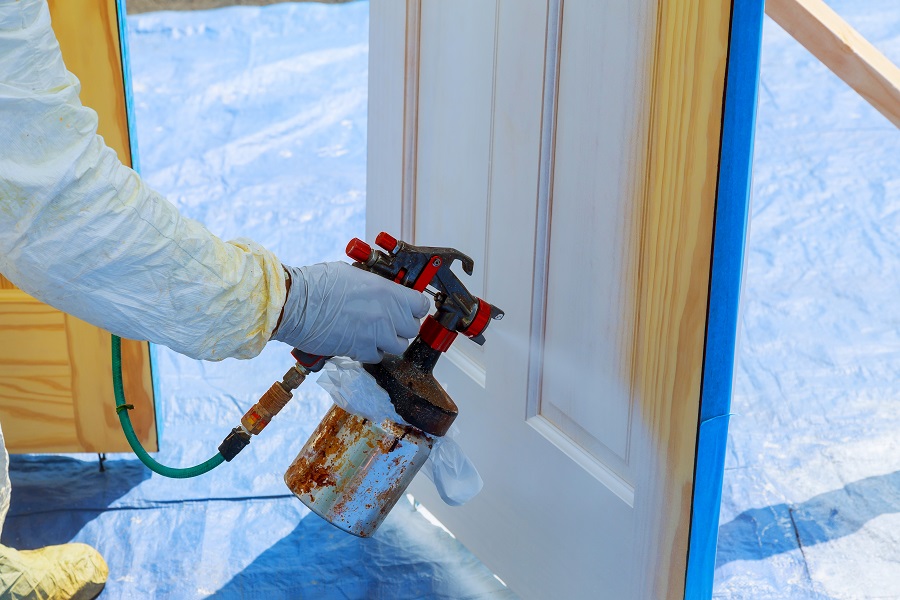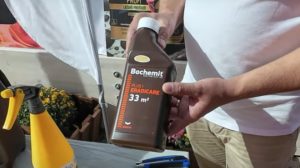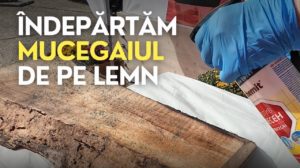The other day I saw a post on a profile group with a wooden exterior door that had turned from white to creamy-yellow less than 0 month after painting. The owner was trying to find out what it was and if anything could be done. Many complained about the paint's poor resistance to the sun. White paint has a tendency to yellow over time, even indoors. It's a kind of light-induced aging, not just UV radiation. The change in such a short time is, however, caused by the tannin in the wood, which dissolves easily in the water contained in waterborne products. To avoid such problems, when the wood is tannin (oak, acacia, chestnut, walnut, walnut, mahogany), a first coat of sealer is applied before the primer and/or paint coats.

Wood tannin
We've talked about wood tannin before, find the info here here, but I come back a bit to emphasize how much it can affect the finishing process. Fortunately, the presence of tannin, or its coming out when in contact with water, does not affect the strength properties of the wood, only the aesthetics. But here it sometimes intervenes so brutally that the object has to be refinished.
How aggressive his action can be I saw many years ago. In a factory I was finishing strips of acacia wood to be assembled into garden furniture. They were laid all in a row, with a little distance between them, and I was spraying a white water-based paint. I hadn't even got to all the slats and saw that the first one had already turned yellow-green. Even though I had learned about tannin, it was totally out of my head by the time I started finishing. I had to sand the wood again, apply the insulator and then the white paint. Granted, it came out in the end, but I put in a lot more work.
Tannin is not a specific product, it has no well-defined chemical formula to identify it. It is a mixture of acidic compounds, different from plant to plant, which are intended to defend the plant against insects and pests that can harm it. The amount varies from species to species, but also within species. As an indication of the amount, the darker the wood, the more tannin. Our best-known species that are known to be tanninous are oak tree, acacia, nuc, chestnut, ulmul. Exotic species, especially African, are very rich in tannin. Because of their acidity, they can cause not only aesthetic problems, but also problems of hardening or varnish hardening (if catalysts are used).
Tanned wood needs to be insulated. How an insulator behaves
The presence of tannin is not always immediately visible. It is possible to finish oak or walnut and see no change, especially if it is not a light color. If you use a water-based finish, however, it's better not to take any chances. A varnish or paint is considered completely dry after at least 2 weeks. Some experts even say a month. During this time there is water in the film which can dissolve the tannin.
An insulator is not a miracle product or something that can make the price of the finish increase exponentially, so don't bypass it. It's a material that penetrates deep into the wood and hardens there, locking the tannin in. It is applied as through coats so that subsequent coats are not affected, and the application is simple similar to other finishing materials. If the wood stain is to be applied after insulation, the amount and viscosity of the insulator must be adjusted so that the wood can absorb the color.
There are several types of insulators and to be effective, the right ones must be chosen. There are exterior and interior wood sealers, water-based or solvent-based, one or two-component. It's a good idea to ask your varnish and paint supplier for advice and make sure that using the recommended product will not cause problems.
Yellowed exterior door
In the case of the door we started with, the weather-resistant paint made it easier for moisture to be present and the tannin to come out. Exterior products allow moisture exchange with the outside for a longer period. They let water out of the wood and varnish, but they also allow moisture from the outside air to enter. This is why water-based varnish applied to window frames can become foggy, with milky white patches, if there is a period of rain soon after they have been finished and fitted. The spots will disappear when the rain stops and the sun comes out again. But that moisture can cause tannin to come out if the wood has not been insulated.
I am convinced that in this case it was not sun yellowing because the time since painting was very short (one month) and the yellowing was quite uniform. It is impossible for the sun to act in the same way on the entire surface of the door. In shaded and sheltered places, the material is more sheltered and its durability increases. This is why in wooden houses that have been painted for a long time, the color resists under the eaves even if the rest of the color is faded and weather-damaged.
To solve the problem the door needs to be refinished. That means removing all the finish down to the wood, applying a sealant and repainting. This is the only solution to eliminate any risk. Applying another coat of paint over the existing one is not a solution. Tannin can bleed through it as well, and the thickness of the finish becomes too thick leading to reduced elasticity and cracks can develop over time.
I hope you find the above interesting and helpful. And if there are any clarifications or if you have any questions, leave them below in the dedicated space. I will certainly reply.




































If tannin (i.e. wood colorants) were to blame, most likely the yellowing or staining of the white finish would be uneven. If the yellowing is uniform, UV is the cause. Insulating primer and topcoat of acrylic wood stain will be recommended for superior shade stability.
Best regards!